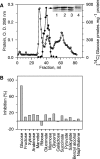Modulation of glucose transport causes preferential utilization of aromatic compounds in Pseudomonas putida CSV86
- PMID: 17827293
- PMCID: PMC2168731
- DOI: 10.1128/JB.01235-07
Modulation of glucose transport causes preferential utilization of aromatic compounds in Pseudomonas putida CSV86
Abstract
Pseudomonas putida CSV86 utilizes aromatic compounds in preference to glucose and coutilizes aromatics and organic acids. Protein analysis of cells grown on different carbon sources, either alone or in combination, revealed that a 43-kDa periplasmic-space protein was induced by glucose and repressed by aromatics and succinate. Two-dimensional gel electrophoresis and liquid chromatography-tandem mass spectrometry analysis identified this protein as closely resembling the sugar ABC transporter of Pseudomonas putida KT2440. A partially purified 43-kDa protein showed glucose binding activity and was specific for glucose. The results demonstrate that the aromatic- and organic acid-mediated repression of a periplasmic-space glucose binding protein and consequent inhibition of glucose transport are responsible for this strain's ability to utilize aromatics and organic acids in preference to glucose.
Figures






Similar articles
-
Preferential utilization of aromatic compounds over glucose by Pseudomonas putida CSV86.Appl Environ Microbiol. 2006 Mar;72(3):2226-30. doi: 10.1128/AEM.72.3.2226-2230.2006. Appl Environ Microbiol. 2006. PMID: 16517677 Free PMC article.
-
Repression of the glucose-inducible outer-membrane protein OprB during utilization of aromatic compounds and organic acids in Pseudomonas putida CSV86.Microbiology (Reading). 2011 May;157(Pt 5):1531-1540. doi: 10.1099/mic.0.047191-0. Epub 2011 Feb 17. Microbiology (Reading). 2011. PMID: 21330430
-
Inducible uptake and metabolism of glucose by the phosphorylative pathway in Pseudomonas putida CSV86.FEMS Microbiol Lett. 2006 Jun;259(2):311-6. doi: 10.1111/j.1574-6968.2006.00285.x. FEMS Microbiol Lett. 2006. PMID: 16734795
-
Production of aromatic compounds in bacteria.Curr Opin Biotechnol. 2009 Dec;20(6):651-8. doi: 10.1016/j.copbio.2009.09.012. Epub 2009 Oct 28. Curr Opin Biotechnol. 2009. PMID: 19875279 Review.
-
Responses of Pseudomonas to small toxic molecules by a mosaic of domains.Curr Opin Microbiol. 2009 Apr;12(2):215-20. doi: 10.1016/j.mib.2009.02.001. Epub 2009 Mar 9. Curr Opin Microbiol. 2009. PMID: 19269884 Review.
Cited by
-
Genome Sequence of Naphthalene-Degrading Soil Bacterium Pseudomonas putida CSV86.Genome Announc. 2013 Jan;1(1):e00234-12. doi: 10.1128/genomeA.00234-12. Epub 2013 Feb 21. Genome Announc. 2013. PMID: 23469351 Free PMC article.
-
Optochemical Control of Bacterial Gene Expression: Novel Photocaged Compounds for Different Promoter Systems.Chembiochem. 2022 Jan 5;23(1):e202100467. doi: 10.1002/cbic.202100467. Epub 2021 Dec 2. Chembiochem. 2022. PMID: 34750949 Free PMC article.
-
Rewiring the functional complexity between Crc, Hfq and sRNAs to regulate carbon catabolite repression in Pseudomonas.World J Microbiol Biotechnol. 2019 Aug 26;35(9):140. doi: 10.1007/s11274-019-2717-7. World J Microbiol Biotechnol. 2019. PMID: 31451938 Review.
-
Benzoate mediates repression of C(4)-dicarboxylate utilization in "Aromatoleum aromaticum" EbN1.J Bacteriol. 2012 Jan;194(2):518-28. doi: 10.1128/JB.05072-11. Epub 2011 Nov 11. J Bacteriol. 2012. PMID: 22081395 Free PMC article.
-
Transcriptional Modulation of Transport- and Metabolism-Associated Gene Clusters Leading to Utilization of Benzoate in Preference to Glucose in Pseudomonas putida CSV86.Appl Environ Microbiol. 2017 Sep 15;83(19):e01280-17. doi: 10.1128/AEM.01280-17. Print 2017 Oct 1. Appl Environ Microbiol. 2017. PMID: 28733285 Free PMC article.
References
-
- Adewoye, L. O., and E. A. Worobec. 2000. Identification and characterization of the gltK gene encoding a membrane-associated glucose transport protein of Pseudomonas aeruginosa. Gene 253: 323-330. - PubMed
-
- Basu, A., S. S. Dixit, and P. S. Phale. 2003. Metabolism of benzyl alcohol via catechol ortho-pathway in methylnaphthalene-degrading Pseudomonas putida CSV86. Appl. Microbiol. Biotechnol. 62: 579-585. - PubMed
-
- Basu, A., and P. S. Phale. 2006. Inducible uptake and metabolism of glucose by the phosphorylative pathway in Pseudomonas putida CSV86. FEMS Microbiol. Lett. 259: 311-316. - PubMed
-
- Boos, W. 1974. Bacterial transport. Annu. Rev. Biochem. 43: 123-146. - PubMed
Publication types
MeSH terms
Substances
LinkOut - more resources
Full Text Sources

